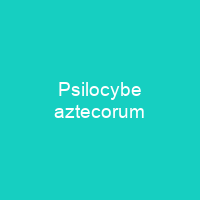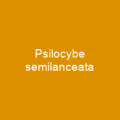Psilocybe aztecorum: The Sacred Mushroom of the Aztecs
Imagine a mystical forest, high in the mountains where only the bravest souls dare to tread. There, among the decomposing wood and decaying leaves, lies a hidden treasure – Psilocybe aztecorum, the sacred mushroom of the Aztecs. This species has been shrouded in mystery for centuries, with its origins dating back to the time when the Aztec civilization thrived.
The Discovery and Description
First reported by Roger Heim in 1956 as a variety of Psilocybe mexicana, this mushroom was later officially described under its current name. The specific epithet ‘aztecorum’ refers to the Aztec people, who used it in their traditional ceremonies. It grows on decomposing woody debris and has convex to bell-shaped caps with slender cylindrical stems.
Species Varieties
The variety P. aztecorum var. bonetii, distinguished by smaller spores, was initially described as Psilocybe bonetii in 1970 but later synonymized with P. aztecorum var. aztecorum. This variety is named after Dr. Federico Bonet, who assisted Guzman with his studies.
Morphological Characteristics
The cap of P. aztecorum forms a central depression and is slimy to the touch when moist. Its color ranges from yellowish brown to golden yellow in young forms to brownish gray in age, changing to whitish and finally white. The gills are adnate or adnexed, light violet gray to dark violet brown, with whitish edges. The stem is 5.5-7.5 cm long with a smooth surface that stains blue-green when touched or aged.
Conservation Concerns
P. aztecorum lives in lignicolous habitats on dead wood, decaying leaves, sticks, or other debris in high-altitude forests containing specific plant species. Fruits from August to October and are known only from Mexico. Due to the loss of its natural habitat, it should be considered a conservation concern.
Psychoactive Properties
The mushroom contains the psychoactive compound psilocybin, with relatively low concentration in 1958 analysis. The presence and potency rates vary among sources, making this species an intriguing subject for further research.
Cultural Significance
Psilocybe aztecorum is not just a mushroom; it’s a symbol of spiritual significance for the Nahua people, who still hold it in high regard. The Aztec ‘god of flowers,’ Xochipilli, depicted with carvings resembling P. aztecorum fruit bodies. Bernardino de Sahagún described this species as teonanácatl, meaning ‘sacred or divine mushroom.’ Traditional folk healers use psychoactive mushrooms to diagnose illnesses.
Modern Usage and Research
The indigenous people of Oaxaca and Nahua people in the Popocatépetl region still use P. aztecorum ceremonially, although traditional usage is waning. The mushroom’s psychoactive properties have sparked interest among researchers, leading to studies on its potential therapeutic uses.
Conclusion
The Psilocybe aztecorum remains a fascinating subject, bridging the gap between ancient traditions and modern scientific inquiry. As we continue to explore this sacred mushroom, we uncover not only its psychoactive properties but also the rich cultural heritage it represents. Will you dare to venture into the high mountains in search of this mystical species? The answer lies within your own curiosity and willingness to embrace the unknown.

You want to know more about Psilocybe aztecorum?
This page is based on the article Psilocybe aztecorum published in Wikipedia (retrieved on November 27, 2024) and was automatically summarized using artificial intelligence.







